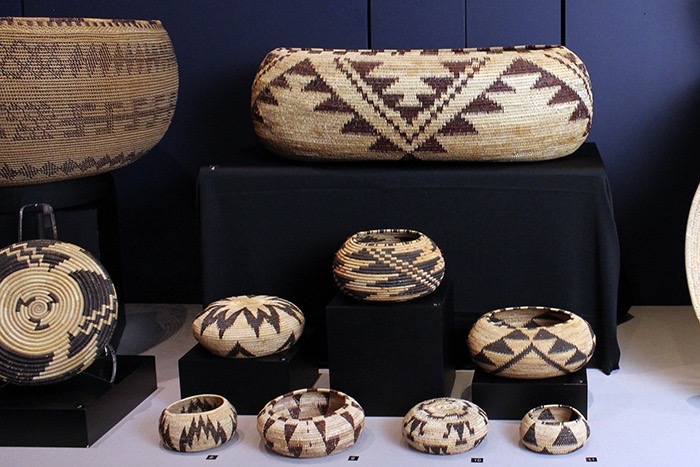Hidden within the lush landscapes of Tanzania, the Pogolo people have nurtured a fine art of basket weaving that not only serves functional purposes but embodies their rich cultural tapestry. The intricate designs passed down through generations are not merely patterns but tell stories of resilience and community. This tradition, echoing centuries of practice, links past and present in a rhythmic dance of craftsmanship.
Historically, Pogolo basket weaving represents more than an artistic pursuit; it is a way of life deeply embedded in the cultural identity of the Pogolo people. With over 70% of Tanzanian homes relying on woven goods daily, these baskets are indispensable. This art form, both elegant and utilitarian, mirrors the harmonious blend of need and expression critical to sustaining community bonds and traditions.

Pogolo Basket Weaving: Art and Tradition
Pogolo basket weaving is a vibrant tradition that connects Tanzania’s past with the present. These baskets are crafted with intricate designs that reflect the unique stories and symbols of the Pogolo people. The art of weaving, often passed down through generations, serves as a symbolic gesture that embodies cultural identity. According to the article, this craft not only provides functional items but also helps maintain community traditions. Despite modern influences, the Pogolo people continue to cherish this art form as a vital part of their culture.
Materials used in Pogolo basket weaving are sourced directly from nature, showcasing the resourcefulness of the artisans. Grass, leaves, and palm fibers are the primary materials. Weaving techniques vary in complexity, ranging from simple patterns to elaborate designs. This craftsmanship is a skill that showcases artisans’ dedication and creativity. Here is the post that describes how each piece tells a unique story through vibrant colors and textures.
The significance of Pogolo basket weaving transcends mere craftsmanship; it strengthens community bonds. In many Pogolo families, weaving is a collective activity bringing together individuals of all ages. Younger generations learn from their elders, ensuring the tradition continues. Many Pogolo communities maintain weekly gatherings where stories and techniques are shared. This communal interaction reinforces the weave of community life.
Promoting and preserving the art of Pogolo basket weaving is crucial to its survival. This can be achieved through educational programs aimed at younger generations and showcasing these beautiful works to broader audiences. Initiatives, such as cultural fairs and exhibitions, create awareness and appreciation. Additionally, partnerships with art organizations can help bring this traditional craft to a global stage. According to the article, such efforts put the spotlight on preserving this rich legacy for future generations.
Artist takes ancient tradition of basket weaving in new directions
Interpreting the Cultural Significance
The cultural significance of Pogolo basket weaving goes beyond utility and enters the realm of storytelling. Each intricate pattern woven into the baskets carries a narrative unique to the Pogolo people. These patterns symbolize various aspects of their community life, from agricultural practices to spiritual beliefs. They serve as a visual language, providing insight into the Pogolo’s way of life. Although modern influences are ever-present, this traditional craft remains a vital cultural expression.
Baskets play an essential role in important ceremonies and rituals within Pogolo society. They are often used to carry gifts and offerings, symbolizing goodwill and respect. During weddings, baskets are exchanged between families, strengthening bonds and fostering unity. The Pogolo people also use baskets in religious ceremonies, where they hold sacred items. This ritualistic use highlights the deep connection between basket weaving and cultural heritage.
The art of Pogolo basket weaving functions as an educational tool, teaching younger generations about their heritage. Elders pass down weaving techniques, along with stories and traditions, creating a bridge between past and present. This form of education is invaluable in preserving cultural identity. Here is the post that discusses the importance of such practices in maintaining community cohesion. By engaging in this traditional craft, the youth connect with their roots and uphold their rich cultural legacy.
To appreciate the cultural significance fully, one must consider the economic impact of basket weaving on the Pogolo community. Many families rely on the sale of their handcrafted baskets for their livelihood. This craft provides a sustainable source of income, allowing artisans to support their families while preserving their heritage. The economic benefits underscore the importance of continuing this tradition. With growing awareness, more people are recognizing the cultural value embedded in every woven piece.
Materials and Techniques in Pogolo Basket Weaving
Pogolo basket weaving relies on natural materials found in their environment, showcasing the artisans’ creativity and resourcefulness. The primary materials include grass, leaves, and palm fibers. These elements not only provide strength and durability but also lend a natural beauty to each piece. Once gathered, the materials are thoroughly dried to ensure flexibility. This preparation is crucial for creating sturdy and long-lasting baskets.
The techniques used in Pogolo basket weaving vary in complexity, reflecting the skill level of the artisan. Simple patterns often start with basic weaving methods, gradually advancing into intricate designs. Artisans take pride in their ability to combine different techniques to achieve unique patterns. This skillful blend of techniques results in beautiful, functional creations. This diversity showcases the adaptability and expertise of Pogolo weavers.
Some common techniques include coil weaving, twining, and plaiting. Coil weaving involves wrapping materials around a core, creating a spiral pattern. Twining uses two strands woven over and under warp elements, adding strength to the structure. Plaiting, on the other hand, creates a checkerboard effect by interlacing materials. These various methods demonstrate the rich tradition of Pogolo weaving.
In keeping with tradition, Pogolo weavers often incorporate cultural symbols into their designs. These symbols tell stories and pass down family and tribal histories. The choice of design reflects the intended use of the basket, whether for daily chores or ceremonial purposes. With a growing appreciation for handcrafted goods, more people recognize the artistry and skill involved in Pogolo basket weaving. Such recognition encourages the preservation and promotion of these valuable techniques.
The Role of Basket Weaving in Pogolo Community
Basket weaving plays a crucial role in Pogolo society, serving as a cornerstone for community and culture. This craft is a communal activity where young and old gather to work together, sharing stories and experiences. Beyond the art itself, these gatherings strengthen social ties and foster a sense of belonging. Elders passing down weaving techniques ensure cultural continuity. This ongoing tradition helps nurture a strong community bond.
Economically, basket weaving provides livelihood opportunities for many Pogolo families. Selling handcrafted baskets at local markets generates income that supports their households. As demand for eco-friendly products grows, these artisans are reaching wider audiences. This trend not only boosts family income but also elevates their craft on a global scale. Increased recognition creates further opportunities for sustainable economic development.
In terms of education, basket weaving serves as an informal classroom where essential skills are taught. Children learn patience, attention to detail, and the value of hard work. These skills are transferable to other areas of life, aiding personal development. Additionally, engaging in this craft helps instill a sense of pride in their cultural heritage. By weaving baskets, they learn about their history and identity.
The significance of basket weaving extends to ceremonial and religious contexts. Baskets hold vital roles in various rites of passage, such as weddings and harvest festivals. During these events, they symbolize abundance, gratitude, and community solidarity. Their role in ceremonies highlights their importance beyond everyday use. These cultural practices emphasize the deep connection between weaving and Pogolo spirituality.
Additionally, basket weaving contributes to the preservation of environmental resources. Artisans utilize natural materials, promoting sustainability and conservation. This approach raises awareness about the importance of protecting their environment. As a result, Pogolo basket weaving not only supports their community but also benefits the planet. This harmonious balance showcases the integral role of weaving in broader ecological efforts.
Preserving and Promoting the Pogolo Basket Weaving Tradition
Preservation of the Pogolo basket weaving tradition involves passing skills and knowledge from generation to generation. This requires active participation in cultural education programs aimed at keeping young people engaged. Hands-on workshops conducted by experienced artisans offer practical learning opportunities. Introducing basket weaving in school curriculums can further support skill retention. These initiatives ensure the continuation of the craft for future generations.
Promoting Pogolo basket weaving on a broader scale requires visibility in both local and international markets. Participating in cultural fairs and exhibitions helps raise awareness of this unique art form. Online platforms and social media further enhance accessibility, showcasing these exquisite creations to global audiences. Such exposure increases demand for authentic, handcrafted products, benefiting artisans economically. Marketing strategies aim to celebrate the rich tradition and its cultural value.
Partnerships with art organizations and museums play a crucial role in preserving Pogolo basket weaving. These collaborations allow for exhibitions and educational programs that highlight the craft’s cultural significance. By working together, these bodies help attract attention from art enthusiasts worldwide. These initiatives help emphasize the importance of preserving traditional crafts. The support from these partnerships ensures the legacy is honored.
To ensure sustainability, incorporating eco-friendly practices into basket weaving is essential. This involves using natural materials and minimizing waste throughout the crafting process. Encouraging sustainable harvesting techniques also protects the environment. Emphasizing the green aspect of Pogolo basket weaving appeals to environmentally conscious consumers. This approach fosters a balance between cultural preservation and environmental stewardship.
Ultimately, preserving and promoting Pogolo basket weaving requires a collective effort from the community, businesses, and cultural institutions. By collaborating on initiatives, these groups can create opportunities for growth and recognition. Supporting artisans financially and socially encourages the continuation of this skilled tradition. Engaging a wider audience fosters appreciation for handcrafts globally. Respecting and nurturing this cultural heritage secures its future for the coming generations.

Frequently Asked Questions
Pogolo basket weaving is a rich tradition in Tanzania, combining beautiful artistry with cultural expression. This craft involves using natural resources to support community life and pass down important customs and stories.
1. What materials are used in Pogolo basket weaving?
Pogolo weavers use materials like grass, leaves, and palm fibers gathered from their surroundings. These natural elements are chosen for their strength and flexibility, making them ideal for creating durable and attractive baskets.
Once collected, the materials are dried and sometimes dyed for added color and variation. This process not only enhances the basket’s aesthetic appeal but also ensures that each piece is unique and reflects the artisan’s creativity.
2. How does Pogolo basket weaving contribute to the community?
Basket weaving is a communal activity that brings people together, strengthening social bonds. It provides a means for families to earn income by selling their handcrafted creations locally and beyond.
Additionally, weaving is an educational tool where children learn valuable skills and cultural traditions. These aspects help maintain cultural identity and foster a stronger sense of community unity.
3. What are the different techniques used in basket weaving?
Pogolo artisans use various techniques, such as coil weaving, twining, and plaiting. Coil weaving involves wrapping materials around a core, while twining uses two strands woven around warps.
In plaiting, materials are interlaced to form a checkerboard pattern. These techniques allow artisans to create unique patterns that highlight their skill and artistry.
4. Why is preserving Pogolo basket weaving important?
Preserving this tradition is crucial for maintaining cultural identity and passing down heritage. This craft is a living link to the past, representing stories, beliefs, and practices central to Pogolo life.
Efforts to promote this tradition also have economic benefits, supporting artisans and enhancing their livelihoods. This multifaceted importance makes preservation efforts vital for future generations.
5. How can Pogolo basket weaving be promoted globally?
To promote this craft internationally, artisans can participate in cultural fairs and exhibitions. These events offer platforms to showcase their work and engage with new audiences.
Online campaigns and collaborations with art organizations can also broaden exposure. These methods enhance appreciation for Pogolo basket weaving and ensure its continued growth and recognition worldwide.
The Art of Basket Weaving | Artbound | Season 9, Episode 8 | PBS SoCal
Conclusion
Pogolo basket weaving stands as a testament to the rich cultural heritage and creativity of the Pogolo people. This craft, woven with stories and traditions, not only serves functional purposes but also strengthens community ties. By preserving this art form, the Pogolo people ensure that future generations will continue to honor and understand their important cultural legacy.
Efforts to promote and sustain Pogolo basket weaving are crucial in a rapidly changing world. Through local and international initiatives, we can help highlight the artistic value and socioeconomic benefits of this tradition. As awareness and appreciation grow, Pogolo basket weaving can thrive, bridging the past and future seamlessly.



